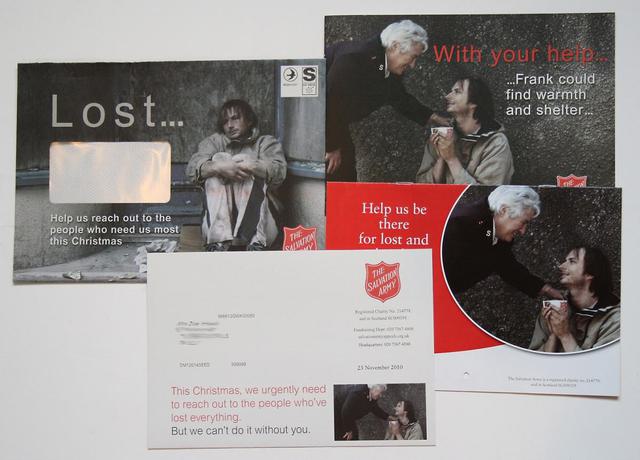The Salvation Army: UK Christmas appeal
- Exhibited by
- SOFII
- Added
- July 17, 2012
- Medium of Communication
- Direct mail
- Target Audience
- Individuals
- Type of Charity
- Community & social services
- Country of Origin
- UK
- Date of first appearance
- November, 2010
SOFII’s view
This very detailed campaign involved different teams from creatives to planners to strategists. Using a variety of channels and approaches the Salvation Army’s campaign proves that if you invest in your fundraising you will raise more money. You will also recruit more donors who will continue to give money over following years.
Watson Phillips Norman (WPN).
Name of exhibitor
Gail Cookson, strategy partner, Watson Phillips Norman.
The Salvation Army’s challenge in 2010 was threefold:
- Deliver more volume than the year before.
- Maintain the return on investment (ROI) of the previous year.
- Convince the Salvation Army’s trustees that increased investment in donor recruitment to the tune of an additional £1 million would be a good investment. And we had to persuade them that we could achieve all of this in a campaign that lasts just 24 days.
Background
The Salvation Army is synonymous with Christmas; for many people, it is the Christmas charity and they will happily drop their spare change in collection tins as the band plays. However undertaking fundraising at a more professional level is a lot more complex than this and grows in complexity each year. The Salvation Army Christmas campaign in the UK has the narrowest window of opportunity, only 24 days in the run up to Christmas to deliver on investment.
Special characteristics
Some donors have rational reasons for giving, some have emotional reasons and some go on a journey. Our strategy was to model this behaviour, to take the insight and analysis to new levels of understanding. It was to develop creative concepts that spoke volumes and which compassionately reinforced the Salvation Army as the Christmas charity. And to overlay the creative execution with new tools that would empower planners to optimise the returns from a finite campaign period.
Direct response analysis has traditionally been done on a linear basis: channel by channel. But with such a multichannel campaign, linear analysis isn’t enough: door drops influence radio response, TV drives warm mail response, etc. Our strategic aim of greater understanding, therefore, had to turn to more complex empirical methods that could offer deeper insights. We turned to multivariate analysis, which gave us a series of equations that explained our results. But equations are no use to planners. So we built a tool, powered by the equations, that allowed media planners to change media investment by channel by day, varying the order of message exposure by channel as well as total investment. We linked this to insight on touchpoints, understanding who saw what and when.
Influence/impact
The creative was compelling, dispelling the image of a cosy Christmas with images that showed in a gritty, compassionate and heartfelt tone the reality of the festive period for the people that the Salvation Army exists to help. By showing the desperate need around Britain and the selfless, hands-on support delivered by the trusted uniformed officers and volunteers, the creative reinforced the urgent need to donate more than spare change. It engaged a variety of audiences to ask for a £19 cash gift via a campaign with 250,000,000+ exposures across 13 separate media channels and four response mechanisms.
Details
We took all the modelling, media and messaging insights to plan the wisest use of the additional £1 million investment from the trustees. In return, the campaign raised over £10 million, which was well ahead of target.
Significantly, the campaign reached a wider audience than ever before and the numbers of new donors increased without significant impact on cold ROI. On the warm donor side, ROI increased by 21 per cent as we generated a greater contribution from the donorbase; spontaneous awareness during the campaign period via TV and other channels prompted donors to be even more generous (admittedly from four per cent to nine per cent). With over 105,000 unique new supporters from this campaign opting to become donors, we can project that they will be truly valuable to the Salvation Army over the next four years – they’ll be worth at least £7,000,000 in donations.
Costs
On top of our budget (figure undisclosed) we were given an additional £1 million investment from the trustees to add to our budget.
Merits
This Christmas appeal delivered stellar results. From a £1 million investment we raised over £10 million – well ahead of target. The campaign reached more people than ever before and increased the number of new donors who will be extremely valuable to the Salvation Army over the next four years.
Direct mail remains the cornerstone of the Salvation Army’s fundraising strategy. The mailing to ‘warm’ donors is absolutely critical – and generates the lion’s share of income – while the communications strategy and channel mix is designed to optimise cold donor recruitment as well as the warm activity. For example, the attribution model (built on results generated in 2009, 2008 and 2007) shows that there is in fact a high correlation between the TV activity and warm mailing response. One other point to make is that the more successful the cold activity in one year, the greater the number of warm mail the following year.
Numerous lessons were learnt from this campaign. From creative testing to new media routes and TV rotation. The spend on TV went up considerably and the strategy of rotating different creative and different lengths helped to maximise effectiveness by keeping the message fresh. Email follow-up to a selection of warm donors also proved to be successful.
 View original image
View original image
Also in Categories
-
- Data and reports
- Multi-media

















